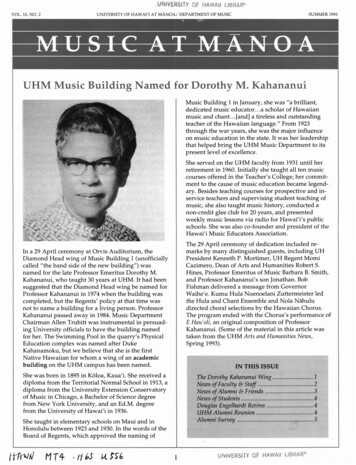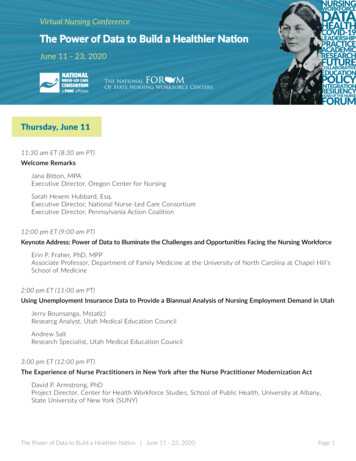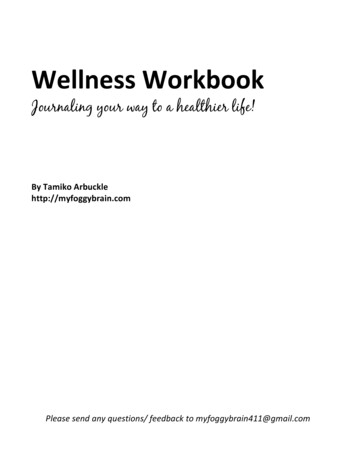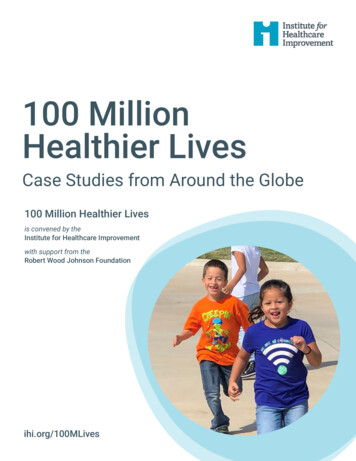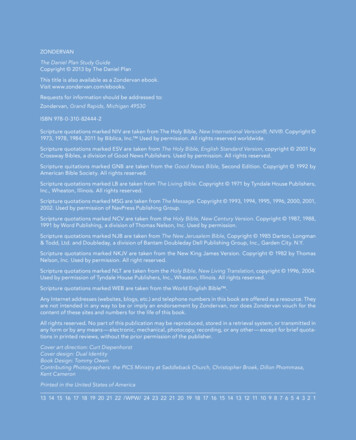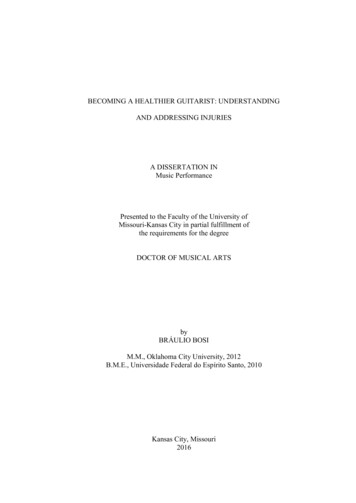
Transcription
BECOMING A HEALTHIER GUITARIST: UNDERSTANDINGAND ADDRESSING INJURIESA DISSERTATION INMusic PerformancePresented to the Faculty of the University ofMissouri-Kansas City in partial fulfillment ofthe requirements for the degreeDOCTOR OF MUSICAL ARTSbyBRÁULIO BOSIM.M., Oklahoma City University, 2012B.M.E., Universidade Federal do Espírito Santo, 2010Kansas City, Missouri2016
BECOMING A HEALTHIER GUITARIST: UNDERSTANDINGAND ADDRESSING INJURIESBráulio Bosi, candidate for the Doctor of Musical Arts DegreeUniversity of Missouri-Kansas City, 2016ABSTRACTThe field of performance arts medicine is supplying musicians with alarmingstatistics regarding their health. Authors give statistics as high as 93% whendiscussing the injury rate among instrumentalists. As guitar is one of the instrumentslisted with the highest incidence of playing-related injuries, this work addresses thetypes of injuries to which musicians, including guitarists, are prone, as well as theircauses and treatment. Musicians often tend to neglect proper treatment for playingrelated injuries, which leads to the conclusion that investing time in preventionmethods is the best choice in regards to injuries. The efficacy of common routines forinjury prevention such as warming-up, taking breaks, among others, has provenstatistically to be successful. Studies show that warm-up routines and periodic breaksfrom music practice seem to be effective against playing-related injuries; the benefitsof stretching, however, remain controversial. Since some of the injuries investigatedare preventable to a large extent through technical adjustments, informed suggestionsfor guitarists are included. Though the solutions presented are not necessarily the onlyones available, they are supported by studies in performing arts medicine.iii
APPROVAL PAGEThe faculty listed below, appointed by the Dean of the Conservatory of Musicand Dance have examined a dissertation titled: “Becoming a Healthier Guitarist:Understanding and Addressing Injuries,” presented by Bráulio Bosi, candidate for theDoctor of Musical Arts degree, and certify that in their opinion it is worthy ofacceptance.Supervisory CommitteeDouglas Niedt, Jr. Committee ChairDivision of Instrumental StudiesAlison DeSimone, Ph.D.Division of Composition, Music Theory, and MusicologyWilliam Everett, Ph.D.Division of Composition, Music Theory, and MusicologyRobert Groene, Ph.D.Division of Music Education and Music TherapySarah Tyrrell, Ph.D.Division of Composition, Music Theory, and Musicologyiv
CONTENTSABSTRACT . iiiLIST OF ILLUSTRATIONS . viiACKNOWLEDGEMENTS . viiiChapter1. MUSICIANS’ INJURIES: AN OVERVIEW . 11.1 The Place of Guitarists in this Discussion . 61.2 Seeking Help (Or Not) . . 121.3 The Effect of an Injury on a Musician’s Career . 142. THE FOUR BROAD CATEGORIES OF INJURIES AFFECTINGMUSICIANS . 182.1 Cumulative Trauma Syndromes . 202.1.1 Causes of Cumulative Trauma Syndromes . 222.1.2 Tendon Injuries . 232.1.3 Joint Injuries . 262.1.4 Symptoms of Cumulative Trauma Syndromes . 272.1.5 Treatment of Cumulative Trauma Syndromes . 292.2 Nerve Entrapment Injuries . 302.2.1 Causes of Nerve Entrapment Injuries 312.2.2 Symptoms of Nerve Entrapment Injuries . 332.2.3 Treatment of Nerve Entrapment Injuries . 342.3 Thoracic Outlet Syndrome . 362.3.1 Causes of Thoracic Outlet Syndrome 36v
2.3.2 Symptoms Thoracic Outlet Syndrome . 372.3.3 Treatment of Thoracic Outlet Syndrome . 392.4 Focal Dystonia 402.4.1 Causes of Focal Dystonia . 412.4.2 Symptoms of Focal Dystonia . 442.4.3 Treatment of Focal Dystonia . 453. GENERAL CONSIDERATIONS ON RISKS, PREVENTION ANDPROACTIVE IDEAS . . . . 473.1 Warm-up Sessions . 523.2 Breaks and Rests . 563.3 Stretching 613.4 Other Preventive Measures . 653.5 Make the Instrument Adapt to You . 683.5.1 Ergonomics . 683.5.2 The Instrument . 733.6 The Education Factor . 754. SPECIFIC SITES OF INJURIES IN GUITARISTS ANDPREVENTION . 834.1 Back and Leg Injuries . 854.2 Shoulder and Neck Injuries . . 914.3 Arms and Wrists Injuries 984.3.1 Issues and Injuries of the Left Arm, Hand and Wrist . 1174.3.2 Issues and Injuries of the Right Arm, Hand and Wrist 124REFERENCE LIST . 131VITA . 137vi
LIST OF ILLUSTRATIONSFigurePage1. Femur, tibia and fibula: “the load-bearing pillarsfor the weight of the body” . 702. Normal configuration of the spine 873. Different types of guitar ergonomic supports . 894. Muscles in the hand 1035. Fragment of Joaquin Rodrigo’s Fandango in the original fingering . 1116. Fragment of Joaquin Rodrigo’s Fandango in the suggested fingering . 1117. Fragment of Heitor Villa-Lobos’ Etude n 7with a conventional right hand fingering . . . 1128. Fragment of Heitor Villa-Lobos’ Etude n 7with an alternative right hand fingering . . . . 1129. Fragment of Antonio Lauro’s Pasaje Aragüeñowith a conventional right hand fingering . . . 11310. Fragment of Antonio Lauro’s Pasaje Aragüeñowith an alternative right hand fingering . . . 11311. Deep branch of radial nerve . 12012. Guitar standing in a vertical position . 12413. Guitar inclined towards the guitarist’s chest . 12414. Wrist gently curved to reach the strings . 12815. Wrist is arched to reach the strings . 12816. No extra forces required to hold the instrument . . 12917. Right arm must be used to hold the instrument . 129vii
ACKNOWLEDGEMENTSAfter two years researching the literature available in the field of performingarts medicine and musicians’ injuries, many acknowledgements should be given topeople that helped me make this work possible.The first steps in this direction would not have been possible if my colleagueMarina Medici Subtil had not invited me to contribute to her work on injuryprevention in musicians at Universidade Federal do Espírito Santo (Brazil). Thispartnership eventually resulted in a book on musicians’ health, A Saúde do Músico emFoco: Olhares Diversos (The Musician’s Health in Focus: Multiple Perspectives) thatwe co-authored and which was the inspiration for this dissertation.Among all my professors who helped me grow as a musician and researcher, Iwould like to specially thank Mr. Douglas Niedt and Dr. William Everett. As myguitar instructor, Mr. Niedt taught me to work with an open mind as a guitarist andunderstand that there are multiple solutions to guitar technique issues, and though wemust observe the past, guitar performance is an evolving art. This mindset is largelyreflected in this work. Helping me grow as a researcher, Dr. William Everett was theperson who helped me think of the multiple questions that have to be asked in anyfield of research; he inspired me to be curious about multiple fields and to develop myresearch practice from that curiosity.And last but not least, I would like to acknowledge the important work that thelibrary staff at the University of Missouri-Kansas City did in helping me find thesources used in this work. Their hard work allowed me to explore an extensive list ofresources to support my arguments in this dissertation.viii
CHAPTER 1MUSICIANS’ INJURIES: AN OVERVIEWAs the field of performing arts medicine evolves, it becomes clear why itshould be taken seriously. The statistics shown in multiple studies in this relativelynew research area converge to an alarming scenario in which musicians, professionalsand amateurs, are exposed to significant risks of injuries of several kinds and degreesthat could alter the path of their careers. Musicians need to know that they are at risk,as well as realizing where, how and why injuries can occur. Their consciousness mustbe raised so they realize the importance of maintaining good physical health.Though numbers vary and there are different understandings as to what isconsidered a playing-related injury by the researcher or by the subjects interviewed,some studies estimate that the rate of upper-extremity musculoskeletal disordersamong professional musicians ranges from 39% to 87%, and between 34% and 62%among secondary school music students.1 Other authors acknowledge an even widerrange of playing-related injuries among instrumental musicians, with injury ratesvarying from 26% to 93%.2The Netherlands, a country that is estimated to have 13,000 professionalmusicians in its population, has a musculoskeletal injury rate of over 60%, in whichthe musicians were injured to the point where performance was “impossible for some1Tim Morse et al., “A Pilot Population Study of Musculoskeletal Disorders in Musicians,”Medical Problems of Performing Artists 15, no. 2 (June 2000): 81.2Christine Guptill and Christine Zaza, “Injury Prevention: What Music Teachers Can Do,”Music Educators Journal 96, no. 4 (June 2010): 28-9.1
time.”3 The numbers in this study led Rietveld to conclude that although acute injuriescaused by music making are rare, injuries are often caused by chronic “imbalancebetween load and load-bearing capacity” and overuse and/or misuse while makingmusic.4A study performed by Morse et al. involving 209 people who stated that theyplayed a musical instrument, professionally or not, concluded that this activity “maybe second only to computer use in prevalence as a possible risk factor for cumulativetrauma disorder.”5 In this study, 29% of all musicians indicated significant pain, withkeyboardists and guitarists leading these statistics, reporting 33% and 30%respectively.6Though the sample sizes of some of these studies might be relatively small,they tend to point towards the same direction and support larger-scale studies. Forexample, a study done with more than 1,000 musicians found that 36% had musclefatigue and/or strain as consequences of “poor technique, inadequate supports, badposture, or overuse/misuse” and that “45% had recognizable structural disordersaggravated or precipitated by technical factors.”7Another study indicated that playing-related injuries can affect musiciansoutside of classical music as well. In a survey performed by Buckley and Ralph, 111exclusively non-classical musicians were questioned about whether they had ever3A. B. M. (Boni) Rietveld, “Dancers’ and Musicians’ Injuries,” Clinical Rheumatology 32(April 2013): 430-1.4Ibid., 431.5Tim Morse et al., 81.6Ibid., 84.7John L. Rigg, Randy Marrinan, and Mark A. Thomas, “Playing-Related Injury in GuitaristsPlaying Popular Music,” Medical Problems of Performing Artists 18, no. 4 (December 2003): 151-52.2
experienced an injury that they felt was attributed to playing a musical instrument.Their results showed significant and disconcerting numbers: 54% (60 participants)reported “having had a playing-related injury at some time,” while 19% (21participants) said that the injury “currently bothers them.”8Among conservatory students, different studies from different authors haveconcluded that 20% of them report a career-altering injury at some point.9 Thesestudies also show that female musicians are at a higher risk of developingmusculoskeletal injury, especially string and keyboard players.10 This information onfemale musicians calls for special attention as data shows that the incidence ofplaying-related musculoskeletal disorders among female musicians can be twice thatof their male counterparts,11 with authors claiming that it may be partially due to“women being smaller in stature and more prone to hypermobility.”12 A survey usinga significant sample size of 4,457 musicians (2,345 female and 2,112 maleparticipants) over ten academic years (between 1986 and 1996) published by Cayeaand Manchester was consistent with the information presented above.13 According totheir findings, female musicians presented an overall injury rate of 8.9% while malemusicians had an injury rate of 5.9%. The authors of this study also acknowledge8Taylor Buckley and Ralph Manchester, “Overuse Injuries in Non-Classical RecreationalInstrumentalists,” Medical Problems of Performing Artists 21, no. 2 (June 2006): 81-82.9Tim Morse et al., 82.10Sarah J. Wu, “Occupational Risk Factors for Musculoskeletal Disorders in Musicians: ASystematic Review,” Medical Problems of Performing Artists 22, no. 2 (June 2007): 50.11David Johnson, “Classical Guitar and Playing-Related Musculoskeletal Problems: ASystematic Review” (research document, Lund University, 2009), 15, accessed April 3, 2016,https://lup.lub.lu.se/luur/download?func downloadFile&recordOId 1530017&fileOId 1530022.12Ibid.13Danelle Cayea and Ralph Manchester, “Instrument-Specific Rates of Upper-ExtremityInjuries in Music Students,” Medical Problems of Performing Artists 13, no. 1 (March 1998): 21.3
consistency with the previous findings, which revealed injury rates between 9.5% and12.1% among females and between 4.9% and 7.2% among males.14Though women seem to be at a higher risk of playing-related injuries, thisinformation should not mislead us since the entire musician population, includingstudents, is at significant risk, not just one group. Through the analysis of differentstudies, Park, Guptill and Sumsion express their concern with musicians’ health,stating that “a large majority of university musicians have or will experience playingrelated injuries at some time during their careers.”15 Such concerns are exemplified bythe numbers shown by Guptill and colleagues, where college musicians were surveyedand the results revealed that “87% of them reported having experienced a musicrelated injury.”16 A different research study mentioned by Guptill and Zaza in one oftheir publications indicated an injury rate of 25% among music students,17 and whilethese are contrasting numbers, the lower end of these injury rates still raises concerns.When comparing student musicians to a control group of non-musicians,Miller and colleagues found that “music students are more likely to report an upperlimb pain problem.”18 Roach and colleagues published similar data and reported thatpain in the shoulder, elbow, and wrist were found to be two times more likely ininstrumental musicians than in non-musicians, while musicians were 50% less likely14Ibid., 22.15Anna Park, Christine Guptill, and Thelma Sumsion, “Why Music Majors Pursue MusicDespite the Risk of Playing-Related Injuries,” Medical Problems of Performing Artists 22, no. 3(September 2007): 89.16Shannon McCready and Denise Reid, “The Experience of Occupational Disruption AmongStudent Musicians,” Medical Problems of Performing Artists 22, no. 4 (December 2007): 140.17Guptill and Zaza, 28.18Park, Guptill, and Sumsion, 89.4
to have lower-body pain.19 Ritveld states that the “upper extremity is affected in 78%of the musicians’ injuries.”20 Numbers like these support Park, Guptill, and Sumsion’sposition that playing-related injuries among musicians are a real and powerful risk.21Hagglund’s survey with music students from the New England Conservatoryand Boston University’s School of Music found that a significant percentage of themusic students developed symptoms of playing-related injuries during the earlierstages of their music development, namely their high-school and undergraduatestudies rather than their graduate school years.22 The New England Conservatorystudents claimed that the primary contributing factors to developing playing-relatedinjuries were “long hours (38%), over-practicing (30%), and technically challengingpieces (30%),” while the students from Boston University reported that“performing/preparing for performance (77%), pressures from self (72%), and schoolrequirements (66%)” were the main contributing factors.23The results of these studies presented thus far, using varied sample sizes,populations, and analyses, creates an alarming scenario, placing the entire musicianpopulation at considerable risk when pursuing professional activities.19Sang-Hie Lee et al., “Intervention Program in College Instrumental Musicians, withKinematics Analysis of Cello and Flute Playing: A Combined Program of Yogic Breathing and MuscleStrengthening-Flexibility Exercises.,” Medical Problems of Performing Artists 27, no. 2 (June 2012):85.20Rietveld, 431.21Park, Guptill, and Sumsion, 89.22Wu, 46.23Ibid.5
1.1 The Place of Guitarists in this DiscussionAs this project focuses on guitarists, it is essential to summarize the studiesthat isolate individual instrumentalists, especially guitarists. Though it is debatablewhich instrument is at the highest risk of playing-related injuries, many writers agreethat the guitar is one of the instruments that pose the highest risks when compared tothe overall population of musicians. A study published by Cayea and Manchester thatexamined instrument-specific injury rates of university-level musicians indicated thatthe highest rates of injuries were among pianists, guitar players and harpists, rangingfrom 12 to 18 injuries per 100 performance major student years.24 Other authors alsoplace guitar as one of the leading instruments for developing a musculoskeletal injury.Rietveld states that “bowed string-players and guitarists together form 53% of injuredmusicians,”25 while Morse’s study places guitarists second only to keyboardists ininjury prevalence.26In order to demonstrate how guitarists are affected by musculoskeletaldisorders, Fjellman-Wiklund and Chesky cite a report from a hand surgical practicethat treated 167 instrumentalists that showed that “guitarists presented mostly leftsided or bilateral strains distal to the elbow, inflammatory conditions, nerve problemssuch as focal dystonia in the hand and fingers, and carpal tunnel syndrome.”27 Inaddition to those more common medical conditions, the authors also listed “guitar-24Tim Morse et al., 82.25Rietveld, 431.26Tim Morse et al., 84.27Anncristine Fjellman-Wiklund and Kris Chesky, “Musculoskeletal and General HealthProblems of Acoustic Guitar, Electric Guitar, Electric Bass, and Banjo Players,” Medical Problems ofPerforming Artists 21, no. 4 (December 2006): 169.6
string dermatitis among other skin conditions, tuft finger fractures, and acro-osteosisas evidenced by the shortening of the distal phalangeal finger bones due to mechanicalstress on the fingers while playing the guitar.”28Fjellman-Wiklund and Chesky also point out that among all types of guitarists,classical players are the most likely to suffer from musculoskeletal problems related toplaying.29 They also emphasize that guitarists who play popular music “alsoexperience playing-related pain in the left hand, wrist, back, and neck.”30 Providingdata from the University of Texas Musician Health Survey, Fjellman-Wiklund andChesky showed that of the 520 popular musicians surveyed, 83% of the acoustic and74% of the electric guitarists reported “one or more musculoskeletal problems.”31Rigg, Marrinan, and Thomas also acknowledge that classical guitarists havetheir own and unique set of injuries due to their formalized posture and handtechniques, but concluded after a survey of guitarists who play various styles ofpopular music (including acoustic and electric guitar as well as amateurs,professionals, and students) that a substantial number of these are also currentlyexperiencing playing-related pain.32 That survey revealed that 61.3% of 261 guitaristssuffered some kind of pain over the last twelve-month period.33 The most oftenreported location for playing-related pain in this study was the fretting hand with28Ibid.29Ibid.30Ibid.31Ibid.32Rigg, Marrinan, and Thomas, 150.33Ibid7
41.8% of the population surveyed reporting pain over the last twelve months, followedby back and neck pain with 17.2% and 14.9%, respectively.34In contrast with Rigg’s study, Dhriti, Agrawal and Aju, distributed aquestionnaire to non-professional guitar players with no history of inflammatory ormedical conditions between the ages of 18 and 30 years old and found out that theneck and lower back were the leading sites of pain, with 29% of the selectedpopulation, followed by wrist and shoulder with 17% and 15.5%, respectively.35 Theauthors of this study suggest that the major cause of complaints could be caused bythe awkward sitting posture for the guitarists who claimed to play guitar while sitting(87.1%).36Scully performed a detailed study to determine the prevalence of playingrelated musculoskeletal disorders to the upper limb in third-level student guitarplayers and their most affected upper limb location.37 In this study, 244 students fromthe University of Limerick (Ireland) completed an on-line survey, and the researchersfound out that 21% (52) of the respondents experienced some degree of pain that“affected their ability to play at the level they were accustomed to,” with fingers andwrist as the most commonly affected areas (60% and 52% respectively).3834Ibid.35M. Aill Dhrithi, Parul Raj Agrawal, and Kurian Aju, “Prevalence of Playing-RelatedMusculoskeletal Disorder (PRMSD) Among Amateur Young Guitar Players,” Journal ofMusculoskeletal Research 16, no. 2 (2003): 1-2.36Dhrithi, Agrawal, and Aju, 3-4.37Darren Scully, “The Prevalence of Playing-Related Musculoskeletal Disorders to the UpperLimb in Student Guitar Players” (research document, University of Limerick, 2011), 6, accessed April3, 2016, 1 Scully D.pdf.38Ibid., 10-13.8
Scully’s study investigated the specific symptoms that had a direct effect onthe guitarists’ ability to play at their highest level and revealed that 15% of therespondents reported weakness or fatigue affecting mostly their wrist (59%), thumb(49%) and fingers (46%), while 28% of the participants suffered from lack of controlaffecting primarily the fingers (58%) and the wrist (57%), with the thumb being muchless affected (36%).39 3% of the respondents experienced numbness that affected theirplaying ability and 6% experienced paresthesia (pins and needles), with the fingersbeing the most common area affected, with 36%.40Overall, excluding mild symptoms of pain, Scully’s study found a prevalenceof playing-related musculoskeletal disorder in 41% of the respondents.41 71% of thoseaffected by the disorder presented one of the symptoms, 19% experienced twosymptoms, while the percentage of those who presented three and four symptomswere 8% and 1%, respectively.42 The author found that fingers and wrist were themost common areas affected among the guitarists surveyed, and that these numbersmatched a previous study that stated that “61% of students in a music school reportedtheir fingers and wrists as being the most affected area.”43Marques et al. studies both classical and flamenco guitarists in order to showhow prone to overuse injuries these types two of guitarists can be. They interviewed64 professional guitarists (32 flamenco players and 32 classical players) who practicedat least three hours a day and the results showed a high prevalence of overuse39Ibid., 16.40Ibid., 16-17.41Ibid., 18.42Ibid.43Ibid., 21.9
syndromes in both groups, especially among the flamenco technique group.44 Of the64 guitarists, 75% showed symptoms of overuse syndrome, and when isolating eachtype of technique, overuse syndrome was reported by 62.5% of the classical guitaristsand 87.5% of the flamenco guitarists, with 50% of the classical guitarists affectedreporting deterioration in playing ability and 82.1% of the flamenco group affectedreporting the same.45According to this study, both types of players presented dorsal and cervicalpain, pain in the forearm, motor discoordination, paresthesia in the fingers, andtension in the upper-extremities as symptoms for overuse syndrome.46 When asked thepossible causes for the appearances of these symptoms, around 40% in each groupanswered that the increased amount of hours of playing time was responsible for it,20% of the classical and 57.1% of the flamenco guitarists responded that they did notknow the reason, and none of the flamenco players attributed it to the change ofrepertoire, in contrast to 40% of the classical guitarists. Most symptoms had abouteven responses in both groups. Dorsal and cervical pain were reported by 53.1% ineach group. Pain in the forearm had a slightly higher incidence in the flamenco group,with 65.6% as opposed to 56.3% among the classical guitarists. Paresthesia in thefingers was reported by 6.3% in both groups, and motor discoordination was reportedby 18.8% of the classical guitarists and 25% of the flamenco players.4744Djalma Nunes Marques et al., “Flamenco Guitar as a Risk Factor for Overuse Syndrome,”Medical Problems of Performing Artists 18, no. 1 (March 2003): 11.45Ibid.46Ibid., 12.47Ibid.10
One symptom particularly caught the researchers’ attention. Tension in theupper extremities had an alarming incidence in 81.3% of the affected flamencoplayers, compared to a still high 56.3% of the classical guitarists.48 In the authors’conclusion, the fact that flamenco guitarists often play in ensembles makes them try toaccentuate the volume of the instrument, thus unconsciously increasing the amount oftension in the hands while attempting to play louder.49 This process is alsoincorporated into practice, which when added to the already tense position of bothhands in flamenco technique can result in overuse syndrome. The differences betweenflamenco performance and style and those of classical playing are the likely reasonsfor the discrepancy in responses.50When discussing the specific areas in which guitarists are affected, Fertmanasserts that fear and anxiety influences the injuries, and under these conditions,guitarists “stiffen up and fall back into all of their worst habits of misuse.”51 Thisinformation suggests that the environment and pressure with which guitarists have todeal might increase the number and severity of injuries and must be taken intoconsideration in the treatment as well as prevention of injuries.When it comes to female guitarists being more prone to playing-relatedinjuries than their male counterparts, the data is inconclusive. Cayea and Manchester’sstudy revealed that women reported no injuries, compared to 15.4% among the male48Ibid., 13.49Ibid.50Ibid.51“The Alexander Technique Can Boost Your Health and Your Career,” InternationalMusician 111, no. 9 (September 2013): 21.11
respondents.52 This study, however, had only 5 female guitarists compared to 39males. Scully also presented data on the subject, and published that 53% of the femaleguitarists who responded to the survey reported having some form of playing-relatedmusculoskeletal disorder, compared to 44% in the male group. The author, however,acknowledge that this difference is not statistically significant based on their samplesize.531.2 Seeking Help (Or Not)The literature might not offer conclusive evidence as to a precise number ofinjury rates or prevalence of pain among musicians in general and guitarists inparticular, but even if the reality falls on the low end of the statistics mentioned, it isstill an alarming scenario for performing musicians. Statistics suggest that guitaristsmay not even know what is causing their playing-related injuries. Many are reluctantto seek professional help, as it would often mean taking time away from theinstrument. Furthermore, corrective measures are not always reaching those who needthis kind of corrective help.The unwillingness to go through the healing process can be observed in thefindings of Guptill, Zaza and Paul. In their survey of college students, only 25% of theinjured group of musicians who responded “sought help from a health professional.”5452Cayea and Manchester, 21.53Scully, 19.54C Guptill, C Zaza, and S Paul, “An Occupational Study of Physical Playing- Related Injuriesin College Music Students,” Medical Problems of Performing Artists 15, no. 2 (June 2000): 86-90.Quoted in McCready and Reid, 140.12
Park et al. interviewed students who reported an awareness of the risks of playingrelated injuries but still opted to play through the pain, since long-term performancerest was not considered a viable treatment option.55 They also presented numbers froma study that found that “79% of their sample population felt that playing through painwas acceptable in overcoming technical difficulties,” confirming that musicians are atmany times unwilling to rest in order to preserve their health.56Heming studied a population of 59 musicians where 70% either suffer or havesuffered a playing-related injury at some point in their career and found that anencouraging 73% sought help.57 Although these initial numbers seem encouraging,75% of the respondents “were reluctant to take time off from playing,” confirming theresults of the studies discussed above.58 The numbers in this study are particularlydisconcerting, as 27% of the interviewed population had an injury that forced them tostop playing, yet a large percentage were still unwilling to take time off.59Wh
Division of Composition, Music Theory, and Musicology William Everett, Ph.D. Division of Composition, Music Theory, and Musicology . 7 John L. Rigg, Randy Marrinan, and Mark A. Thomas, "Playing-Related Injury in Guitarists Playing Popular Music," Medical Problems of Performing Artists 18, no. 4 (December 2003): 151-52. 3
